Downspout Extensions To Consider To Save Your Home's Foundation From Water Damage
We may receive a commission on purchases made from links.
Downspouts provide a controlled escape route for rainwater flowing through your home's gutters. Unfortunately, these devices terminate at the bottom of the home's exterior walls, right next to the home's foundation. This configuration is highly problematic, since water rushing right over the interface between the home's foundation and the surrounding grade can be. In fact, downspouts that are installed in close proximity to the home's exterior walls are the most common culprit behind leaky basements. Fortunately, a suitable downspout extension can help channel the water away from your house and keep your foundation walls dry.
Downspout extensions come in several types. The simplest type is just a pipe that attaches to the mouth of the downspout. You can opt for either a corrugated flex pipe, or an aluminum equivalent. The flex pipe has a major advantage — it's flexible, so you can easily mold it into any shape you like if there are landscaping or hardscaping features in its path. In contrast, the aluminum pipe is just a straight extension that takes the water several feet away from the house. Both of these types are relatively inexpensive, and you can find them for under $10 at Home Depot (for example, this flex spout for $8.67). Rain chutes work much like aluminum extensions, and comprise a pipe that's open at the top. Laying down splash blocks is another option, one that's effective if you have a mulched garden. These blocks carry the gushing rainwater several feet away from the home. These stones offer a more attractive alternative to the more practical aluminum or corrugated flex pipe extensions.
Underground downspout extensions carry water off your property
If you're willing to put the work in, an underground drainage system is the most sophisticated and effective downspout extension type. Not only do these extensions channel the rainwater far away from your home and prevent overflow in your yard, they also keep the extra pipes concealed from view. This solution comprises a system of pipes that connect to the downspout, then run underground to a drainage point on the street or at the local storm sewer system. PVC or corrugated pipes can be used in this application. To install this underground downspout extension, you'll need to dig trenches (or hire someone to do it) from the downspouts to the terminal point at the end of your property. As you can imagine, this is a more involved, costly, and labor-intensive task than simply hooking up a 3-foot corrugated pipe to the end of the downspout.
Apart from the added effort, underground drainage systems come with a few other drawbacks. For one, being underground, they're not easy to keep free of blockages. If you don't really clean your gutters well and debris accumulates there, it can flow down with the rainwater and clog up the buried downspout extensions. When this happens, you risk having the water back up and flood your foundation and basement. One way to prevent these troubles is to install gutter covers — these will keep debris out of your gutters and the drainage system. Also, it's wise to invest in a heavy duty drain auger long enough to clean the buried downspout extensions when needed, like this Husky drain auger from Home Depot ($39.87).

